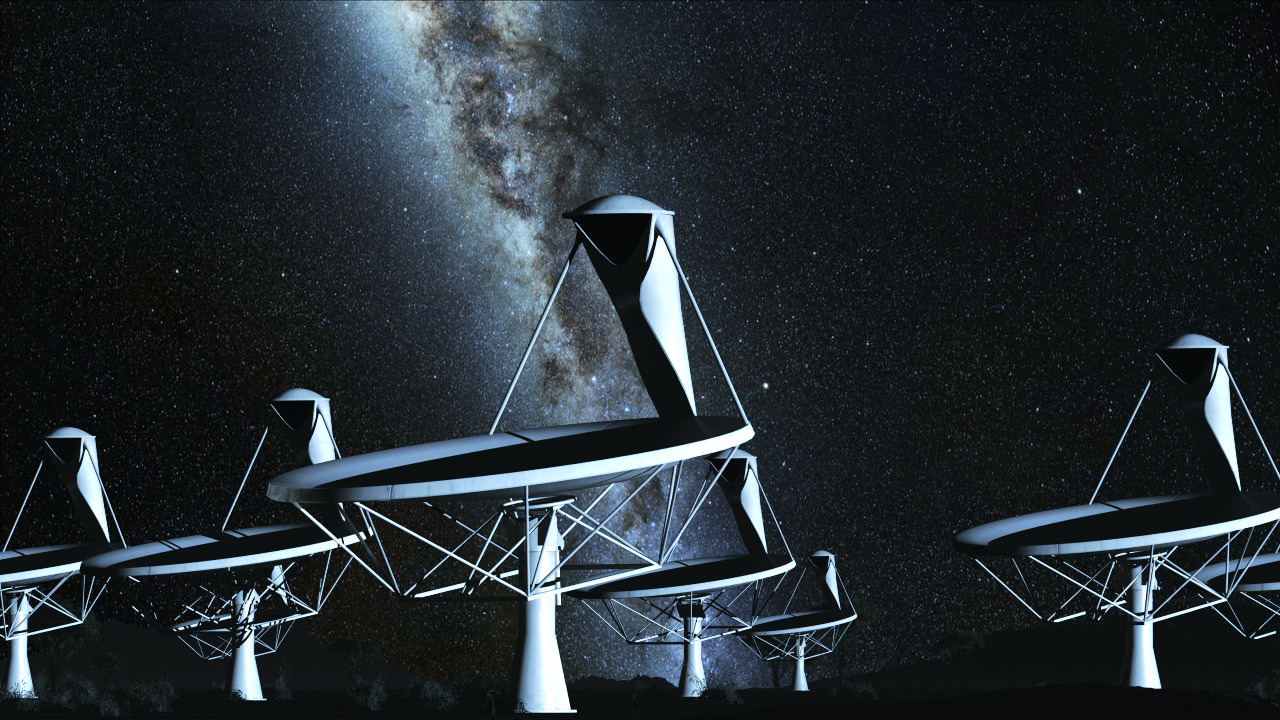We’re still loving all the eclipse photos and videos coming in: Astrophotographer Ted Judah put together this great video showing his views of the May 20, 2012 annular solar eclipse at Sundial Bridge in Redding, California. Not only are there spectacular shots of the eclipse — including views of the simmering surface of the Sun in the annulus of bright light surrounding the Moon at the maximum phase (starting at about 4:00 in the video) — but he shares the joy of astronomy outreach, as Ted set up his telescope and allowed passersby to see eclipsed Sun for themselves. Great music, too by Peter Adams titled, appropriately, “Shoot the Moon.”
Incredible Dragon Approach and Berthing – Image Gallery from Andre Kuipers aboard ISS
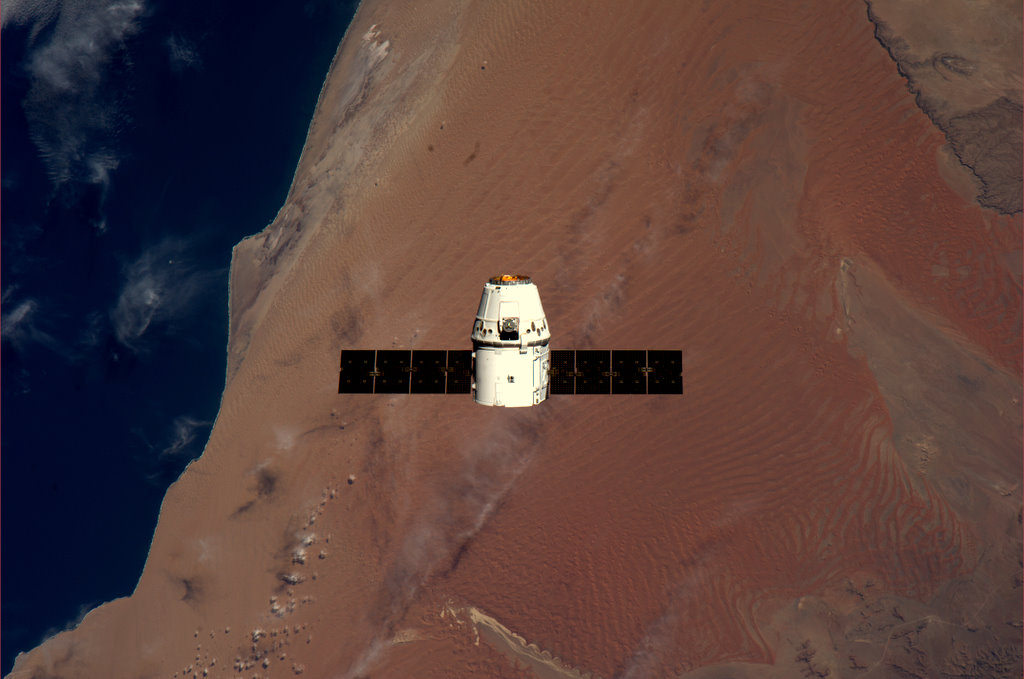
[/caption]
On Friday, May 25, astronauts aboard the International Space Station (ISS) made space history when they deftly reached out with the stations robotic arm and grabbed the approaching SpaceX Dragon resupply carrier and then parked the first ever commercial cargo craft at an open port on the massive lab complex while orbiting some 407 kilometers (253 miles) above Earth – check out the gallery here !
Working in tandem, NASA astronaut Don Pettit and ESA astronaut Andre Kuipers snared the Dragon craft as it was drifting in free space about 10 m (32 ft) away with the 18 m (58 ft) long Canadian robot arm at 9:56 a.m. EDT and connected the first privately built capsule to a parking spot on the Earth-facing side of the Harmony Node 2 module on the ISS at 12:02 p.m. EDT on May 25.
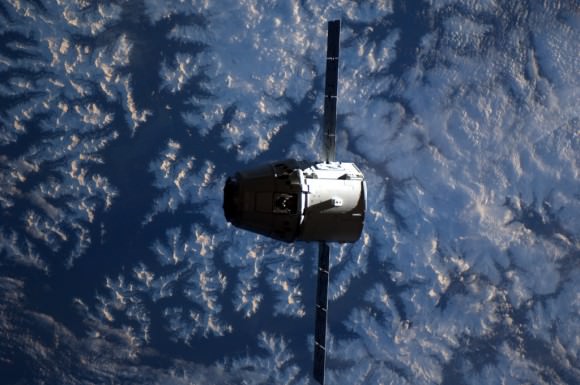
Here’s a gallery of images from Andre Kuipers showing the Dragon’s rendezvous, grappling and docking at the million pound Earth orbiting space station currently inhabited by a crew of 6 astronauts and cosmonauts working as a united team from the US, Russia and the Netherlands and representing humanities tenuous foothold at the High Frontier.
All these photos were taken on May 25, 2012 using a Nikon D2Xs.
The crew ‘Entered the Dragon’ for the first time on Saturday, May 26.
Over the next few days, the crew will unload the living provisions, supplies and equipment loaded aboard the Dragon capsule and then refill it with science samples and trash for the return trip to Earth.
Dragon will undock from the ISS on May 31 and splash down hours later off the coast of California in the Pacific Ocean.
And through May 31, you can spot and photograph the Dragon/ISS combo orbiting overhead – read my article here for further details.
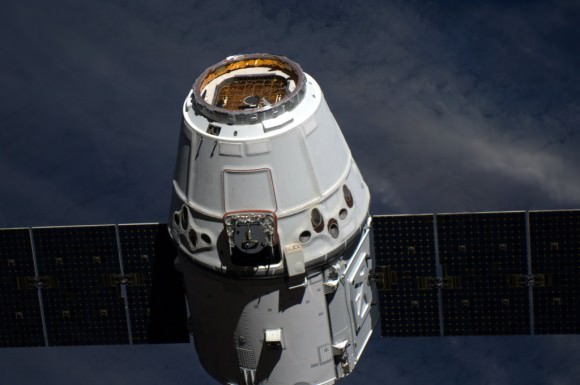
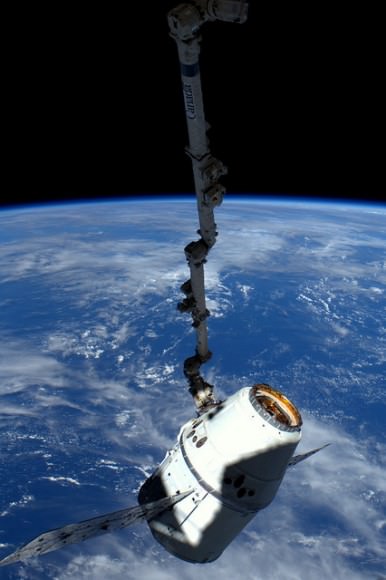
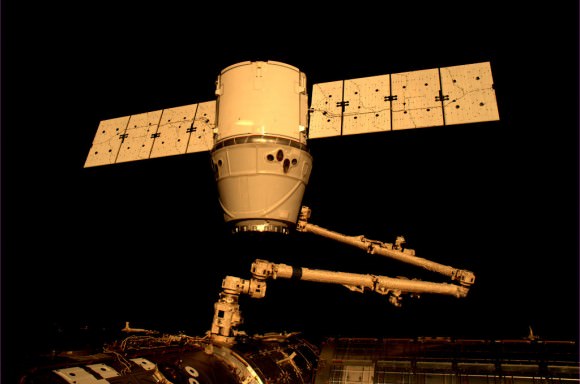
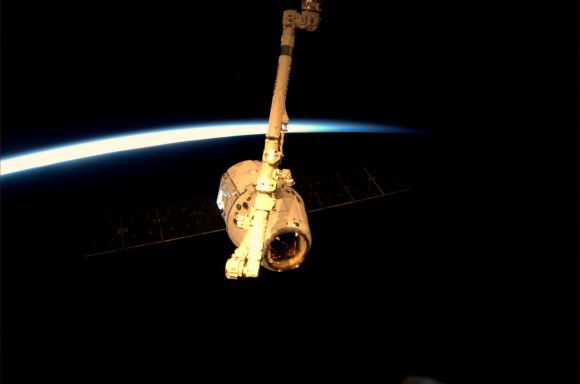
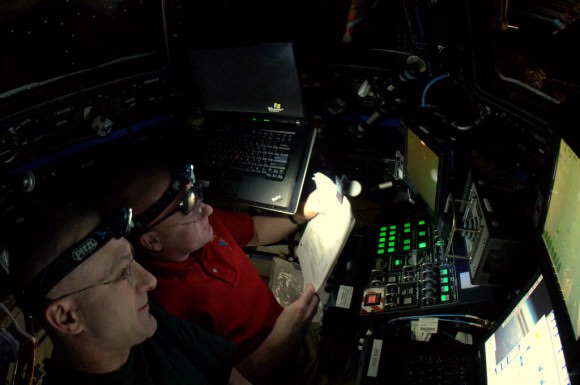
Dragon is the world’s first commercial resupply vehicle. It was launched flawlessly atop a SpaceX built Falcon 9 booster on May 22 from Pad 40 at Cape Canaveral Air Force Station, Florida.
Spot the New Space Era as ISS & Dragon Streak Across the Sky – This Week Only !
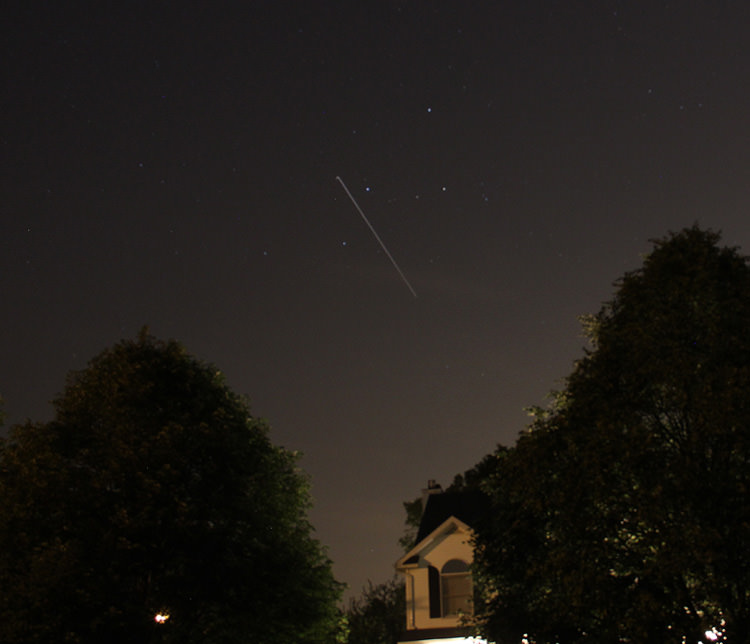
[/caption]
This week and this week only you can see the dawn of the new Commercial Space Era with your own eyes – it’s soaring above your head a mere 400 kilometers (250 miles) away. All you have to do is a quick search, hope for clear skies and traipse outside.
Following the historic attachment of the maiden commercial Dragon cargo carrier to the Harmony node on the International Space Station (ISS) on May 25, the massive orbiting laboratory will be shining just a little bit brighter and prouder as it steaks overhead across the sky at 17,500 MPH (32140 KPH).
Dragon and ISS are literally trailblazing the pathway to the new Commercial Space Era for all to see.
So, for a limited time only between right now and the scheduled May 31 undocking of the SpaceX Dragon spacecraft from the ISS there will be occasional viewing opportunities to catch the dynamic duo speeding merrily across the night time sky.
And the station crew of 6 astronauts and cosmonauts living aboard just opened the hatch from the ISS and “Entered the Dragon” earlier today, May 26 – To make it even more special !
Many folks have never seen an ISS flyover and I can’t think of a better time than now to get started. I’ve held several ISS Sighting star parties in different US States and everyone is thrilled and amazed at how bright the ISS shines – In fact it’s the brightest object in the night sky other than the Sun and the Moon.
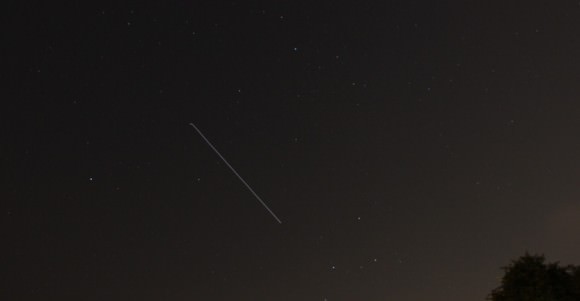
To determine if there are any favorable sighting opportunities in your area, check out the NASA website on Human Spaceflight Sighting Opportunities – here – for a detailed listing of the precise times, elevations, direction and durations. It’s an easy to use viewing guide. Just plug in the particulars of the country in which you live
Another great source is Heaven’s Above – here
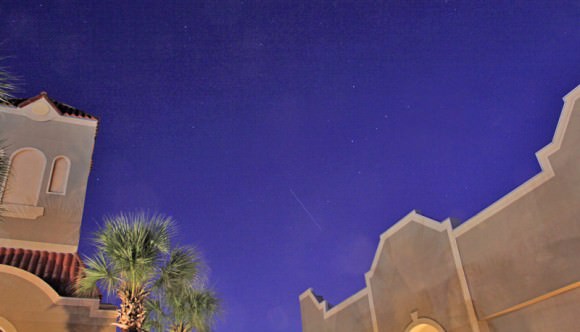
Last night I shot some time lapse astrophotos (above) when the gloomy New Jersey clouds finally cleared using a digital SLR and exposure times of 20 to 30 seconds.
Read my eyewitness account of the spectacular pre-dawn May 19 launch of the Dragon resupply vehicle atop a Falcon 9 rocket from Cape Canaveral, Florida here and the docking here
Now – Go Spot the Dragon and the Station !
and send Ken your blazing Astrophotos to post at Universe Today
Happy Viewing and Clear Skies
Station Astronauts Enter the Dragon – First Private Capsule at ISS
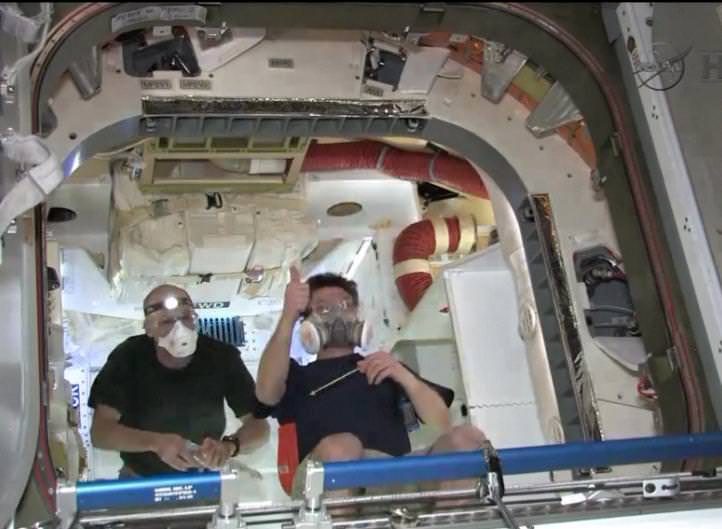
[/caption]
For the first time in history space station astronauts have ‘Entered the Dragon’ .. The 1st Private Capsule in Space !
The hatches between the newly arrived Dragon private capsule and the International Space Station’s Harmony Node 2 module were opened at 5:53 a.m. EDT (0953 GMT) today, Saturday, May 26 as the massive complex was flying 407 kilometers (253 miles) over the Tasman Sea between Australia and New Zealand, just west of Auckland.
NASA astronaut Don Pettit had the honors of opening the hatch to the history making first commercial spacecraft to dock at the ISS and begin a busy few days of unloading gear and supplies.
Clearly the crew was eager for the momentous moment because Pettit and Russian cosmonaut Oleg Kononenko, Station Commander floated into Dragon nearly two hours ahead of schedule for the initial inspections.
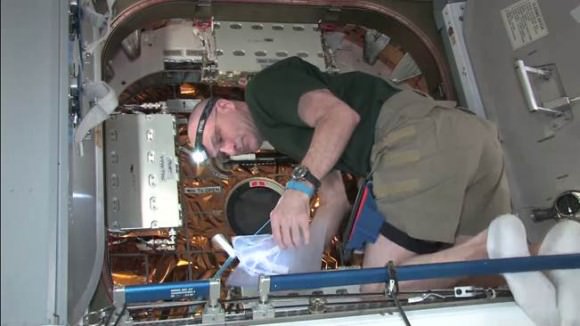
Dragon is the first private spacecraft ever to journey and connect to the International Space Station and marked a milestone event in space history when it arrived yesterday morning on May 25. Dragon is the world’s first commercial resupply vehicle and was built by SpaceX Corporation based in Hawthorne, Calif., founded by CEO and Chief Designer Elon Musk.
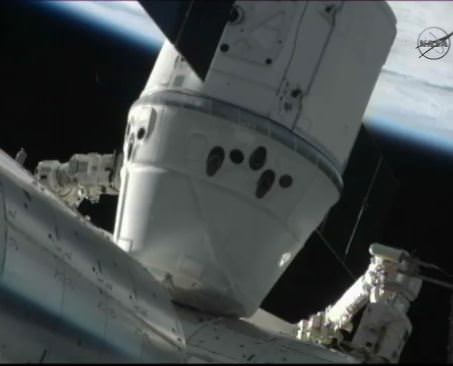
As a routine precaution to guard against possible contamination and floating debris, Pettit and Kononenko wore protective eye goggles and dust masks over their mouths as they floated and somersaulted playfully through the hatch and all looked in ship shape. They took off the protective gear about 20 minutes later after the air had been well mixed and receiving the all clear from Houston Mission Control.
“There was no sign of any kind of FOD (foreign object debris) floating around in the atmosphere inside,” Pettit reported to Houston upon entering the Dragon. “It kind of reminds me of the cargo capability that I could put in the back of my pickup truck, and the smell inside smells like a brand new car.”
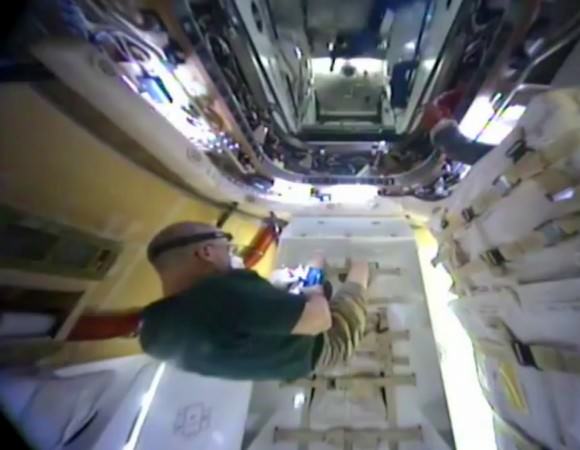
Barely 21 hours ago yesterday morning Pettit snared the Dragon as it was drifting free in space about 10 meters (30 ft) away using the stations 18 m (58 ft) long Canadian-built robotic arm. ESA Astronaut Andre Kuiper then parked Dragon at an open port on the Harmony node. The arm will remain grappled to Dragon throughout most of its docked time.
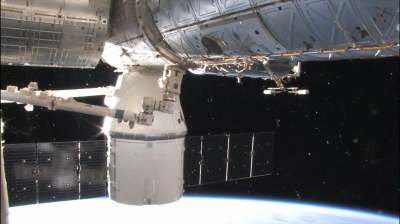
Dragon is a resupply ship meant to replace some of the cargo duties – both up mass and down mass – fully lost with the forced retirement of NASA’s Space Shuttle fleet last year. It is the first American built spacecraft of any kind to visit the ISS since the departure of the final Shuttle mission STS-135 in July 2011.
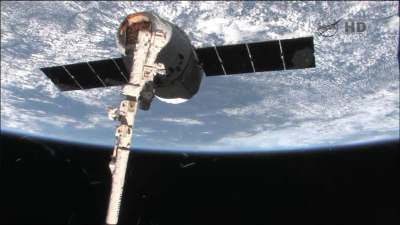
The Dragon was packed with 460 kilograms (1014 lbs) of non-critical cargo including 306 kg (674 lbs) of food and crew provisions; 21 kg (46 lbs)of science experiment; 123 kg (271 lbs) prepositioned cargo bags to be used for future flights; and 10 kg (22 lbs) of assorted computer supplies and a laptop.
The vehicle will be refilled with more than 1400 pounds of science samples, trash and unneeded gear for the trip back home. Dragon is the only ISS cargo resupply vessel that has any significant return to Earth capability since it is equipped with parachutes and a heat shield, unlike the ATV, HTV and Cygnus which burn up on re-entry into the Earth’s atmosphere.
“Dragon is really the main means of carrying cargo back from the space station,” said Elon Musk at a post docking media briefing.
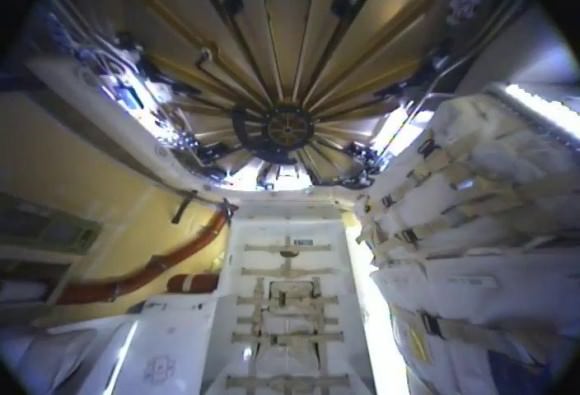
SpaceX is under contract with NASA to conduct a dozen Falcon 9/Dragon resupply missions to carry about 44,000 pounds of cargo to the ISS at a cost of some $1.6 Billion over the next few years.
The first operational Dragon resupply mission to the ISS could launch as soon as September.
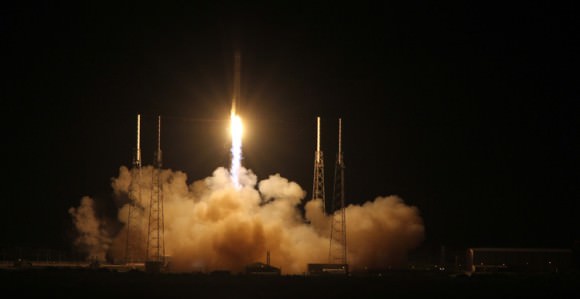
The Dragon was blasted to space atop a SpaceX Falcon 9 booster from Cape Canaveral, Florida on this historic test flight on May 22, 2012 and linked up with the ISS on Flight Day 4 on May 25.
In the Shadow of the Moon: A Lunar View of an Eclipse
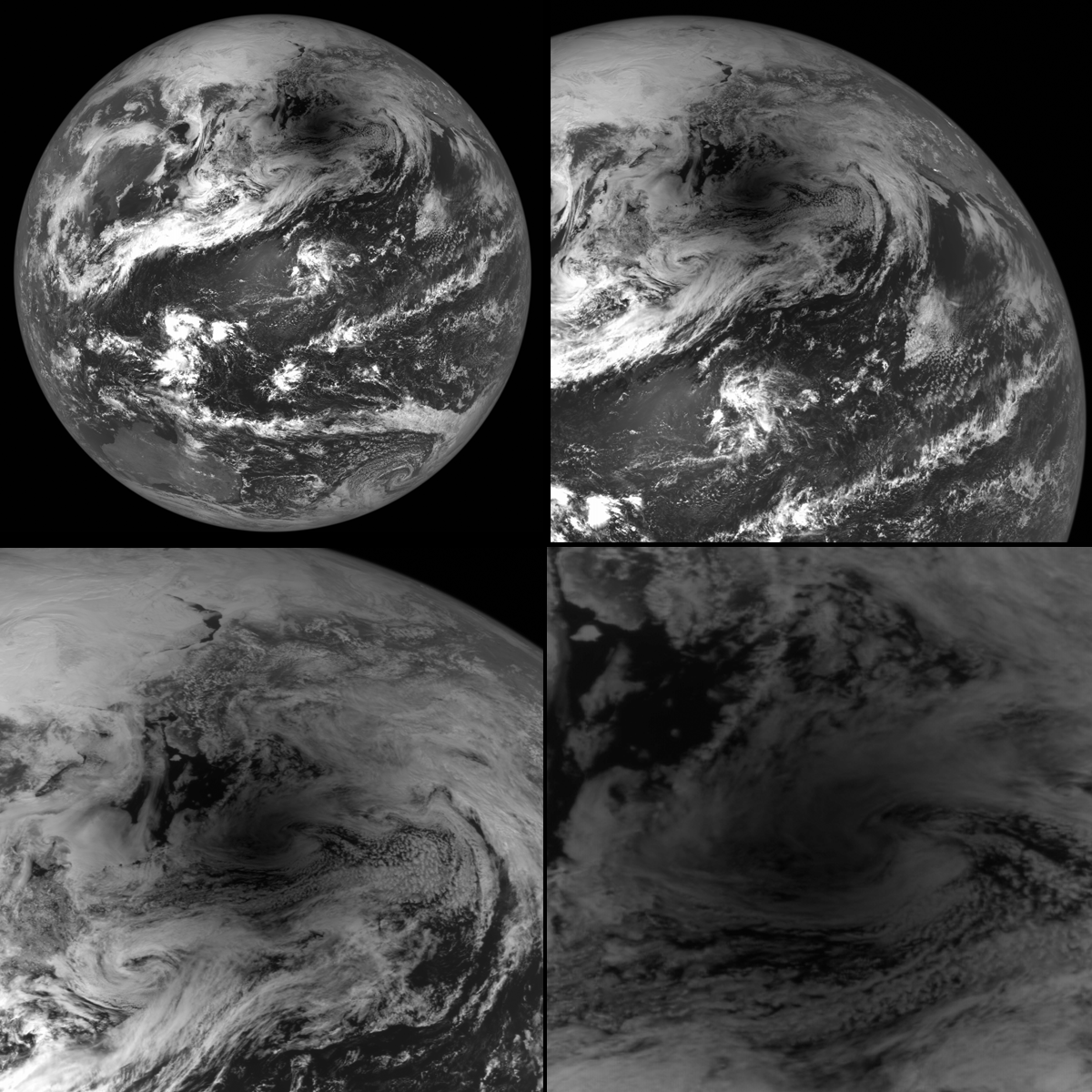
[/caption]
The May 20 annular eclipse may have been an awesome sight for skywatchers across many parts of the Earth, but it was also being viewed by a robotic explorer around the Moon!
During the event NASA’s Lunar Reconnaissance Orbiter turned its camera to look back home, acquiring several images of the Earth with the Moon’s fuzzy shadow cast onto different regions during the course of the eclipse. The image above is a 4-panel zoom into one particular NAC image showing the Moon’s shadow over the Aleutian Islands.
LRO captured a total of four narrow-angle camera (NAC) images during two of its orbits. During one orbit the Moon’s shadow was over the southern part of Japan, and during the next it had moved northeast to cover the island chain of Alaska.
According to the LROC site run by Arizona State University:
The NAC is a line scanner, meaning that it has only one row of 5064 pixels per camera. Instead of snapping a single frame, an image is built up by the motion of the spacecraft in orbit about the Moon (about 1600 meters per second). To obtain an image of the Earth the spacecraft is turned 180° to face the Earth, then the spacecraft is pitched as quickly as possible (one-tenth of a degree per second), so that the image is built up line by line.
This also explains why some of the images are “clipped” on the edges… LRO ran out of time during its lunar orbit. Still, it’s great to be able to show some photos of the eclipse from quite possibly the most distant viewer anywhere!
Read more on the LROC site here.

Videos: Dragon Capsule Now Successfully Attached to ISS
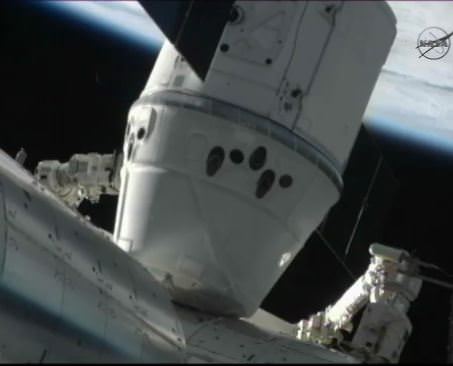
This day will go down in history as the first time a commercial company has their own spacecraft attached to the International Space Station.
After Don Pettit grappled SpaceX’s Dragon capsule with the CanadArm2, Andre Kuipers later installed the capsule on the nadir port of the station’s Harmony node at 15:02 UTC/11:52 a.m. EDT. NASA astronaut Joe Acaba completed berthing operations by bolting the Dragon to Harmony at 16:02 UTC/12:02 p.m. EDT to the space station Friday.
Congratulations on a wonderful capture,” astronaut Megan Behnken radioed to the station crew from Mission Control. “You’ve made a lot of folks happy down here, over in Hawthorne and right here in Houston. Great job, guys.”
More videos, including the post-docking press conference with a jubilant Elon Musk and his SpaceX team.
“Today marks another critical step in the future of American spaceflight,” NASA Administrator Charles Bolden said. “Now that a U.S. company has proven its ability to resupply the space station, it opens a new frontier for commercial opportunities in space — and new job creation opportunities right here in the U.S. By handing off space station transportation to the private sector, NASA is freed up to carry out the really hard work of sending astronauts farther into the solar system than ever before.”
The plan is to wait until Saturday to open hatches. The spacecraft is carrying nearly 460 kg (1,150) pounds of equipment and supplies: 674 pounds of food and crew provisions; 46 pounds of science hardware and equipment; 271 pounds of cargo bags needed for future flights; and 22 pounds of computer equipment.
“The crew is pretty excited so don’t be surprised if they want to open the hatches a little early,” said ISS Flight Director Holly Ridings at a press conference.
The schedule has Dragon remaining berthed to the ISS until May 31. The CanadArm2 will unberth the capsule and then release it. Dragon is the only cargo ship designed to return to Earth with experiments and equipment; others ships such as the Russian Progress, the European ATV and the Japanese HTV all burn up in the atmosphere. The Russian Soyuz crew craft can bring home limited equipment.
[/caption]
SKA, the World’s Largest Telescope Will Be Built at Two Sites
[/caption]
In an anticipated great compromise, South Africa and Australia will share their sites for the Square Kilometre Array telescope, the world’s largest and most sensitive radio telescope. Both sites were competing to win the $2 billion contract for the SKA, which is hoped shed light on how the Universe began, why it is expanding and whether there is any other life beyond our planet.
“We have decided on a dual site approach,” said SKA board chairman John Womersley, following a meeting of the SKA organisation’s members. “This position was reached after very careful consideration of information gathered from extensive investigations at both candidate sites.”
An SKA press release said the majority of the members were in favor of a dual-site implementation model for SKA. The members noted the report from the SKA Site Advisory Committee that both sites were well suited to hosting the SKA and that the report provided justification for the relative advantages and disadvantages of both locations, but that they identified Southern Africa as the preferred site. The members also received advice from the working group set up to look at dual site options.
Therefore, the majority of SKA dishes in Phase 1 will be built in South Africa, combined with MeerKAT, a seven-dish prototype interferometer array built by South Africa, where 190 dishes will be added. 60 dishes will be added to the Australian Square Kilometre Array Pathfinder (ASKAP) array in Australia, as well as a large number of omni-directional dipole antennas. This will give the Australian site a wide-field survey capability, whereas South Africa will be able to look deeply into a narrow part of the sky.
Three antenna types, high frequency dishes and mid and low frequency aperture arrays, will be used by the SKA to provide continuous frequency coverage from 70 MHz to 10 GHz. Combining the signals from all the antennas will create a telescope with a collecting area equivalent to a dish with an area of about one square kilometer.
All the dishes and the mid frequency aperture arrays for Phase II of the SKA will be built in Southern Africa while the low frequency aperture array antennas for Phase I and II will be built in Australia.
“It’s a distinct possibility that we’ll discover a new type of astronomical object,” CSIRO SKA Director Brian Boyle told Universe Today in interview earlier this year. “History has shown that every time we’ve gone to a new astronomical wavelength domain, we pick up new objects.” An example of that is the discovery of pulsars in radio
At the lowest frequencies, the SKA will be looking for red-shifted hydrogen, looking at the very earliest events of our Universe. At highest frequencies will look for things like pulsars or even pre-biotic molecules in space. The array will also be very effective in looking for transient events like supernovae or gamma ray bursts.
“The placement of the array will give it a phenomenally wide field of view, between 30 and 100 square degrees,” Boyle said. “It is hoped to provide the first all-sky survey at phenomenal depths at these wavelengths, which can then be compared with other all-sky surveys done at optical wavelengths.”
One downside of splitting the frequencies between the two sites is that some of the science may suffer. One of the original science requirements of the SKA was to look at the same piece of the sky at the same time in different frequencies. Boyle said there is not much common sky between the two locations.
Another is cost for having redundant computing and networking capabilities, not cheap for the remote areas where both sites are located.
But the dual-site approach solves political issues, and the SKA press release says the arrangement “will deliver more science and will maximize on investments already made by both Australia and South Africa.”
Womersley said that in this approach “Science is the winner,” and by building on existing pilot projects in both countries, the SKA will be made even more powerful.
Additionally, technology is sure to get a boost, as the SKA project will drive technology development in antennas, data transport, software and computing, and power.
Additionally, the SKA members say the influence of the SKA project extends beyond radio astronomy.
“The design, construction and operation of the SKA have the potential to impact skills development, employment and economic growth in science, engineering and associated industries, not only in the host countries but in all partner countries,” said their press release.
Dragon Grappled and Berthed for History Making Docking at Station Today – May 25
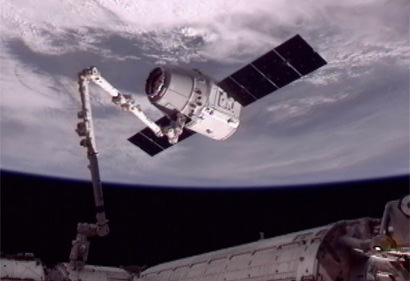
[/caption]
The first private spacecraft – named Dragon – was berthed at the International Space Station (ISS) today, May 25, after being dramatically captured by the astronaut crew earlier this morning using the station’s robotic arm in a landmark event in space history – Dragon is the first commercial spacecraft to attach to the International Space Station.
“Capture is confirmed at 9:56 a.m. EDT [1356 GMT],” said Mission Control Houston commentator Josh Byerly, “as the spacecraft [Dragon & ISS] were passing about 251 miles over northwest Australia. Official mission elapsed time was 3 days, 6 hours and 11 minutes and 23 seconds when capture occurred.”
Two hours later, Dragon was successfully attached to the ISS at 12:02 p.m. EDT when 16 motorized bolts on the common berthing mechanism (CBM) latched and locked the cargo vessel to the Harmony module as the giant complex was soaring over the Pacific Northwest region of the US – concluding a dramatic day of momentus space spectaculars.
“SpaceX has done it. They are the first private company to launch and dock their own spacecraft at the International Space Station. Dragon has been successfully captured.”
“Looks like we caught a Dragon by the tail !” said a gleeful Astronaut Don Pettit of NASA who plucked the Dragon from space with the robotic arm as it was in free drift about 10 meters from the station.
Today’s successful Dragon capture and docking ushers in a new era in the history of spaceflight and will radically change the way we do business in space from this day forward.
NASA’s goal is to significantly drive down the cost of transporting cargo and crews to low Earth orbit by using private commercial companies to foster competition and innovation in the free market – much like happened with the airline industry of last century.

The Dragon cargo resupply capsule is a commercial spacecraft designed and developed by SpaceX and was flawlessly launched atop a Falcon 9 booster from Cape Canaveral, Florida on a historic test flight on May 22 to become the first private vehicle ever to rendezvous and dock at the million pound orbiting space complex.
Following a successful series of close approach rendezvous tests on Thursday, May 24, when it flew to the ISS from behind and below during fly-under maneuvers to within 2.4 km (1.6 mi), the commercial cargo carrier was cleared for final rendezvous, grappling and docking today.
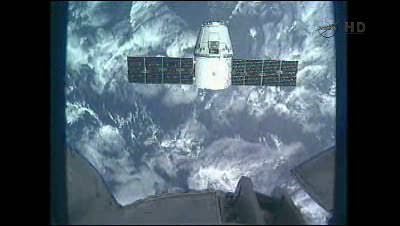
This morning at about 7 a.m. EDT Dragon was given permission to enter the so called keep out sphere (KOS) which is 200 meters from the station. KOS is an imaginary circle drawn around the ISS that prevents the risk of collision with the massive orbiting lab complex. The ISS is orbiting some 400 km (250 miles) above Earth.
Dragon utilized a combination of LIDAR laser ranging and thermal imagers sensors to determine distance as it closed in on the ISS to the final hold point about 10 meters (30 ft) away for final capture by two astronauts on board at work stations located inside the Cupola dome maneuvering the stations robotic arm. The Dragon’s thrusters are disabled at the 10 meter point to prevent an accidental firing and any undesired movement leading to a potential collision.
Dragon was commanded by the SpaceX flight control team based in Hawthorne, Calif, to slowly approach the ISS from below, gradually stopping along the way at ever closer hold points (250 m, 200 m, 150 m, 70 m, 30 m, 10 m) to confirm the crafts position and velocity and that all spacecraft navigation systems were functioning properly to insure a safe capture and berthing operation.
Dragon reached the 30 m hold point at about 9:14 a.m. EDT and then had to wait for final approval and before proceeding closer to the station.
Dragon arrived at the final 10 m hold point at about 9:45 a.m.
“Crew is ready for Dragon capture,” said ISS Astronaut Kuipers from the European Space Agency (ESA).
“You have a go for capture,” said Houston Mission control at about 9:49 a.m. EDT
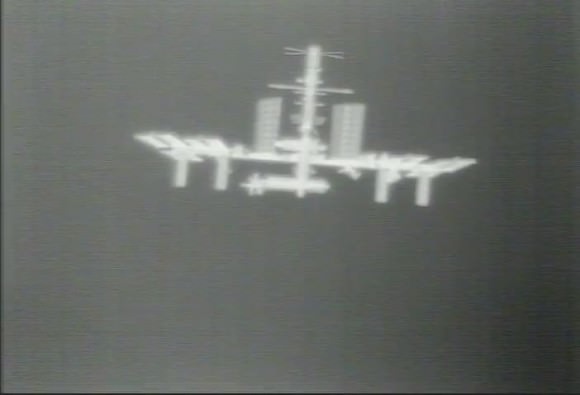
Some stray retro reflections emanating from the external pallet on Japanese Kibo module affected measurements by the Dragons LIDAR system causing a minor 2 hour delay in final approach and grappling as the unit was recalibrated. Indeed one of the LIDAR units was taken offline due to suspect readings but the mission still continued. Since this is a test flight delays are to be expected.
Expedition 31 Flight Engineers Don Pettit and Andre Kuipers worked in tandem using the Canadarm2 robotic arm to reach out and grapple the supply ship shortly before 10 a.m. EDT for berthing to the Earth-facing side of the station’s Harmony node later today.
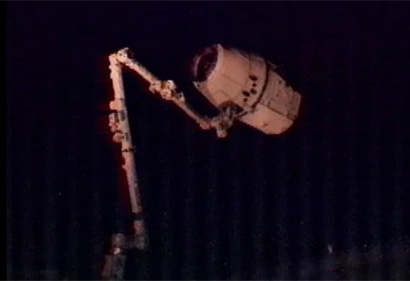
Pettit successfully grappled the Dragon with the robotic arm at 9:56 a.m. EDT Kuiper accomplished the berthing a few hours later.
Pettit inspected the Dragon’s berthing mechanism with high powered binoculars after the grappling was done and found it to be in good shape for the subsequent joining to the ISS with sign of no damage from micrometeoroids.
“It looks like a clean interface,” said Pettit to Mission Control.
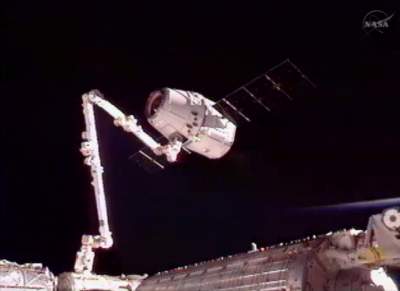
Dragon is scheduled to spend about a week docked with the station before returning to Earth for a parachute assisted splashdown in the Pacific Ocean off the coast of California on May 31 for an ocean retrieval.
For this initial test flight Dragon is loaded with over 460 kg (1100 pounds) of non-critical items such as food, water, clothing as well as research equipment and student science experiments.
The ISS crew expects to open the hatch and enter the Dragon for the first time on Saturday, May 26.
SpaceX has invested about $1.2 Billion in development of the Falcon 9 and Dragon space vehicles and also received about $381 Million in funding from NASA under the Commercial Orbital Transportation Services (COTS) initiative to develop commercial cargo vehicles to resupply the station.
Dragon will partially replace the cargo carrying duties that were totally lost when NASA’s space shuttles were prematurely and forcibly retired by US politicians after the final shuttle mission in July 2011. No American vehicle has visited the ISS since the shuttle shutdown. The US is now fully dependent on the Russians to ferry astronauts to the ISS for at least the next 3 to 5 years or more and the gap continues to grow as NASA’s budget is slashed by visionless politicians.
SpaceX is under contract with NASA to conduct a dozen Falcon 9/Dragon resupply missions to carry about 44,000 pounds of cargo to the ISS at a cost of some $1.6 Billion over the next few years.
The first operational Dragon resupply mission to the ISS is expected later this year, perhaps as soon as late summer.
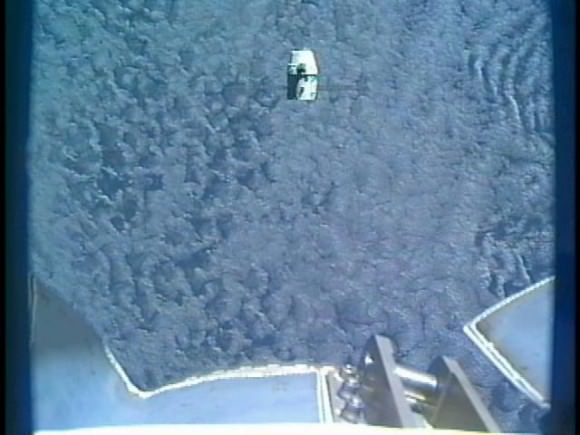
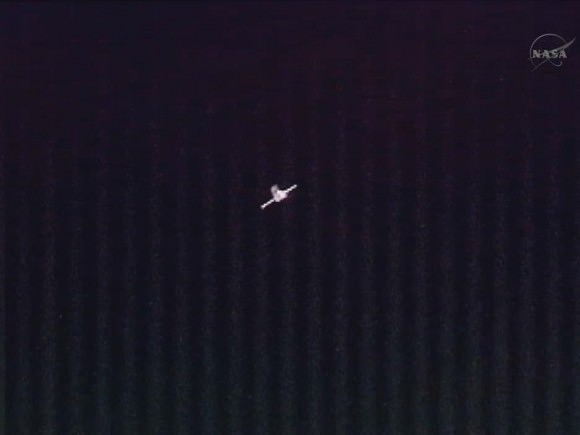
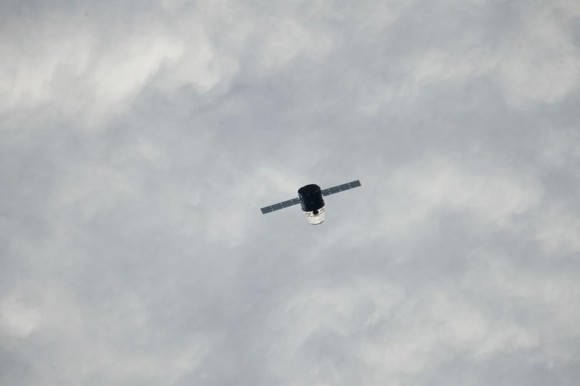
A mission status briefing was held at 1 p.m. EDT to discuss the day’s activities and all the days momentous events were broadcast live on NASA TV.
The high stakes Dragon mission to the High Frontier has been a resounding success thus far and its importance to NASA’s future and the future of human spaceflight cannot be overstated.
Ecological Concerns in Losing Our Starry Night
[/caption]
Images of the Earth at night, taken from space are always a stunning sight, with cities, countries and whole continents glittering like jewels. But this beauty comes at a price. It used to be that anyone looking up on a clear night could see the Milky Way. As more and more of us are drawn to live in urban areas, our view of the sky is blotted out by the glare of our lights. Astronomers have known about the growing problem of light pollution for a long time. Now ecologists are becoming concerned that our artificial lights are affecting more than our view of the stars.
Researchers at the University of Exeter studying the ecological impact of artificial lighting have noted changes in distribution of invertebrate communities around artificial lighting which could affect the broader wildlife that depend on them. Simply put, it is easier for predators to find their prey, and harder for the prey to hide, in brightly lit areas. Streetlights may also be disrupting the natural rhythms of both fauna and flora, changing hibernation patterns and flowering times. It may also be affecting our own circadian rhythms as well as being a colossal waste of energy, an estimated $2.2 billion per year in the U.S. alone! On average, 30% of the light from a streetlight shines up and out.
Light pollution is a growing problem. Artificial lighting is increasing at the rate of 6% each year globally and is only going to get worse, as developing nations use more and more electric light. Since 1988 The International Dark-Sky Association has campaigned to protect and preserve the night environment and promote energy efficient options. Light what you need, when you need it, they say.
One of their projects is the International Dark Sky Places program which certify locations with exceptional nightscapes, either as communities, parks or reserves. The Kielder Forest and adjacent Northumberland national park covering 400 square miles in the UK is the latest area hoping to join the 12 dark sky reserves already recognised by the IDA worldwide. Such status can bring economic advantages too, astronomy is rapidly growing in popularity and with it astronomy based tourism, offering dark skies, observing opportunities and star parties and star camps.
Losing the stars can have a lasting impact on our culture too. Think of all the art, literature and music that have been inspired by the night sky. As we become increasingly disconnected from nature the stars are one of our most important links. There are many people today who have never been able to look up and see the Milky Way arching over their heads. Looking up at the stars allows us a vital opportunity to engage with the larger questions posed by the universe.
Find out more at The International Dark-Sky Association
and The British Astronomical Association’s Campaign for Dark Skies
Shuttle Replica Departs Kennedy for Ocean Voyage to Houston on a Barge – Enterprise is Next
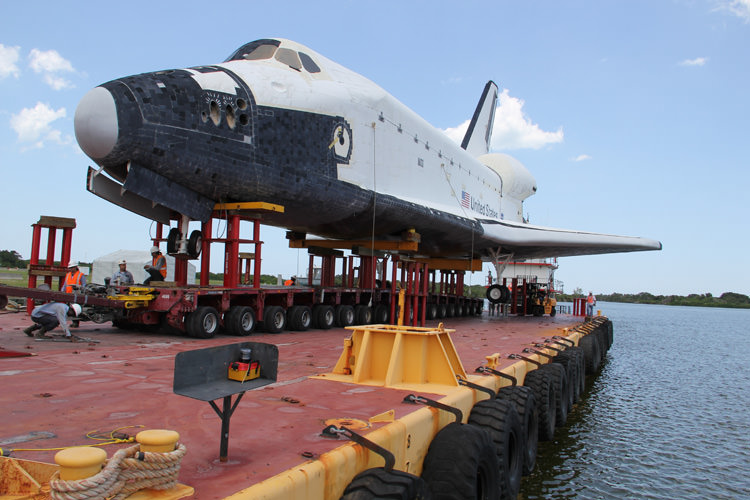
[/caption]
A high fidelity replica of a NASA Space Shuttle orbiter has set off today, May 24, on an ocean going voyage by barge for NASA’s Johnson Space Center in Houston, Texas. This trip by the Shuttle replica gives a taste of what’s to come for the upcoming barge journey by Space Shuttle Enterprise around the southern tip of Manhattan in early June.
The replica model formerly named “Explorer” departed early this morning from the turn basin at the Kennedy Space Center in Florida in the shadow of the iconic vehicle Assembly Building (VAB) where the real Space Shuttles and Apollo Moon rockets were assembled for launch.
The space shuttle replica first moved through the inter-costal waterway and then set sail out from Port Canaveral and into the Atlantic Ocean this afternoon for about a week’s voyage that will take her southwards around the coastline of the Florida peninsula and then into the Gulf of Mexico on a heading for Houston, Texas.

The shuttle model was towed onto the barge at KSC Tuesday afternoon (May 23) by Beyel Bros. Crane and Rigging who are responsible for loading it. Beyel workers then welded the shuttle model to the deck of the barge.
None of the real space shuttles had ever been located at this position at KSC before near the VAB and waterways and provided truly amazing and unique photographic opportunities.
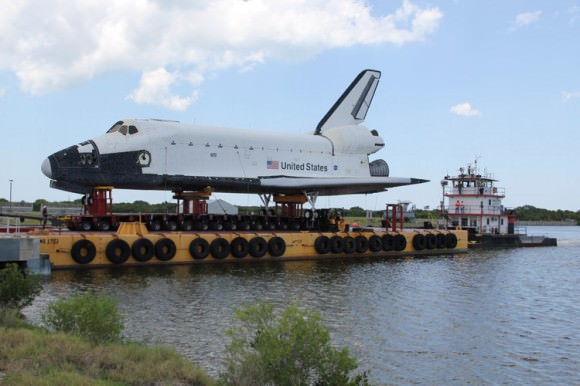
The full scale replica – with the moniker Explorer removed – is being transported to her permanent new home at Space Center Houston, the visitor complex at NASA’s Johnson Space Center in Texas.
It will arrive in Houston around June 1, depending on the weather, where a free three day public arrival welcome “Shuttlebration Weekend” is planned.
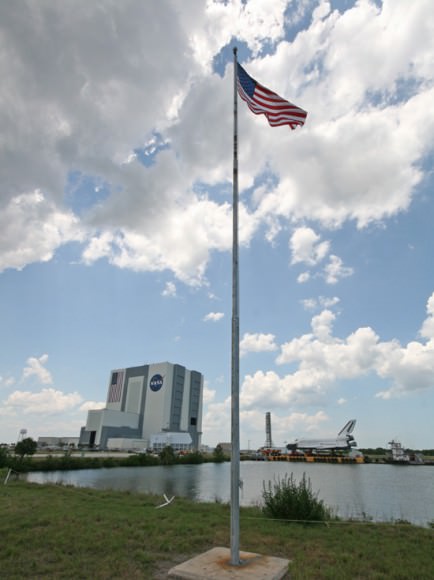
The Explorer had been on display alongside a gantry like tower at the Kennedy Space Center Visitor Complex (KSCVC) since 1993 and was enjoyed by millions of tourists since then along with full scale replica versions of the shuttle’s twin solid rocket boosters and huge external fuel tank.
The Explorer model was built was built in Apopka, Fla., by Guard Lee using schematics and blueprints provided by NASA. It’s the next best thing to having a real space shuttle. The model’s length is 122.7 feet, its height is 54 feet, and its wingspan is 78 feet.
Having been up close and inside all three of NASA’s real space shuttles, I can say that the Explorer mockup is an excellent representation of the genuine shuttle orbiters and gives a realistic sense of the airframe, heat shield tiles, cockpit and cavernous cargo bay. At KSCVC, visitors could see directly into the cargo bay housing a satellite. The Michelin wheels were genuine and had actually flown in space.
The Explorer was moved out from Kennedy’s Visitor Center on a 144 wheeled trailer in December 2011 by Beyel Bros to make way for Space Shuttle Atlantis. Atlantis will be towed to the KSC Visitor Complex in November 2012. The Visitor Complex is constructing a humongous permanent new display hall for Atlantis which is slated to open in 2013.
The Space Shuttle program was forcibly shutdown for lack of money at the direction of politicians in Washington DC after the final flight, STS-135, lifted off in July 2011, leaving the US with no capability to transport astronauts or cargo to the International Space Station since then.
The two other remaining space flown shuttles were assigned to museum locations near Washington, DC and Los Angeles. Discovery has already departed in April 2012, flying atop a 747 Jumbo Jet to the Smithsonian Air and Space Museum’s Annex outside Washington, DC.
The Endeavour will take the last cross country airplane trip of the shuttle program in September to her permanent new resting place at the California Science Museum. The Shuttle prototype orbiter Enterprise will be displayed at the Intrepid Air, Sea and Space Museum in New York City starting in mid-July 2012.
The Explorer is a consolation prize of sorts for the Johnson Space Center (JSC), which lost out on the nationwide bidding to display the three now retired NASA Space Shuttles.
JSC was home to the training facilities for the Space Shuttle crews and home to the NASA astronauts who flew aboard the five shuttle orbiters for the 30 year life of the Space Shuttle program. Many folks feel JSC was shortchanged in the shuttle museum home selections process.
On Sunday, June 3, the replica shuttle will arrive at Space Center Houston where it eventually will become part of a unique display telling the story of the Space Shuttle’s achievements and the nationwide team that made them possible. Further details about Space Center Houston – here

